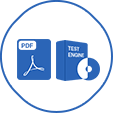Last Update 17 hours ago Total Questions : 60
The SAP Certified Associate - Process Data Analyst - SAP Signavio content is now fully updated, with all current exam questions added 17 hours ago. Deciding to include C_SIGDA_2403 practice exam questions in your study plan goes far beyond basic test preparation.
You'll find that our C_SIGDA_2403 exam questions frequently feature detailed scenarios and practical problem-solving exercises that directly mirror industry challenges. Engaging with these C_SIGDA_2403 sample sets allows you to effectively manage your time and pace yourself, giving you the ability to finish any SAP Certified Associate - Process Data Analyst - SAP Signavio practice test comfortably within the allotted time.
Which Widgets can visualize process flows by backtracking the performed events? Note: There are 2 correct answers to this question.
What does the so-called Best Run Score in Plug and Gain by SAP Signavio indicate?
Which Process Performance Indicator categories are most relevant when striving to identify automation potential? Note: There are 2 correct answers to this question.
What are some benefits of Process Mining? Note: There are 3 correct answers to this question.
How does Process Mining help organizations to achieve business process excellence? Note: There are 3 correct answers to this question.
What features does the SQL Query Editor offer? Note: There are 2 correct answers to this question.
How can KPIs be visualized in the SAP Signavio Process Collaboration Hub? Note: There are 3 correct answers to this question.

